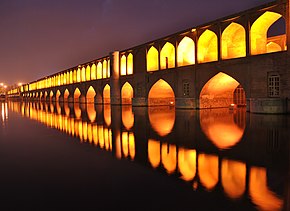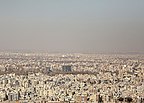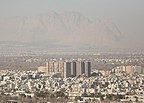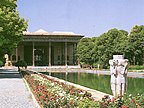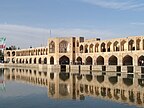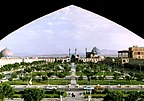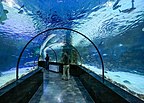
Back Isfahan AF Isfahan ALS ኤስፈሃን AM أصفهان Arabic اصفهان ARZ Isfahán AST İsfahan AZ ایصفاهان AZB Исфаһан BA Ісфахан BE
Isfahan
اصفهان | |
|---|---|
city | |
| Ancient names: Spahān, Aspadana | |
| Persian transcription(s) | |
|
Clockwise from top: Si-o-se-pol, The City of Isfahan, Khaju Bridge, Isfahan Aquarium, Naghsh-e Jahan Stadium, Flower Garden of Isfahan, Naqsh-e Jahan Square, Chehel Sotoun, and The City of Isfahan. | |
| Nickname: Nesf-e Jahān (Half of the world) | |
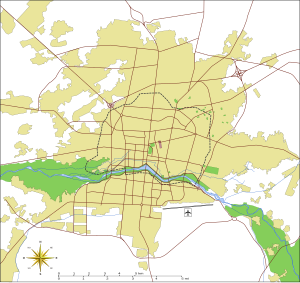 Isfahan | |
Isfahan in Iran | |
| Coordinates: 32°38′N 51°39′E / 32.633°N 51.650°E | |
| Country | Iran |
| Province | Isfahan |
| County | Isfahan |
| District | Central |
| Government | |
| • Mayor | Ghodratollah Norouzi |
| • City Council | Chairperson Fathollah Moein |
| Area | |
| • Urban | 551 km2 (213 sq mi) |
| Elevation | 1,574 m (5,217 ft) |
| Population (2016 census) | |
| • city | 1,961,260 |
| • Population Rank in Iran | 3rd |
| Population Data from 2016 Census[2] | |
| Time zone | UTC+3:30 (IRST) |
| • Summer (DST) | UTC+4:30 (IRDT 21 March – 20 September) |
| Area code | 031 |
| Climate | BWk |
| Website | www.isfahan.ir |
Isfahan or Esfahān (historically also rendered as Ispahan or Hispahan, Old Persian: Aspadana, Middle Persian: Spahān, Persian: اصفهان Esfahān) is the capital of Esfahan Province in Iran. It is about 340 km south of Tehran. It has a population of 1,583,609. It is Iran's third largest city after Tehran and Mashhad.

Isfahan was once one of the largest cities in the world. It was strong from 1050 to 1722, particularly in the 16th century under the Safavid dynasty. During this time it was the capital of Persia for the second time in its history. Even today, the city keeps much of its past glory. It is famous for its Islamic architecture, with many beautiful boulevards, covered bridges, palaces, mosques, and minarets.
The Naghsh-e Jahan Square in Isfahan is one of the largest city squares in the world. It is an outstanding example of Iranian and Islamic architecture. It is a UNESCO World Heritage Site. The city also has a many historic monuments.
